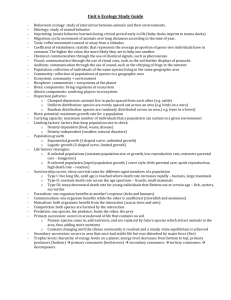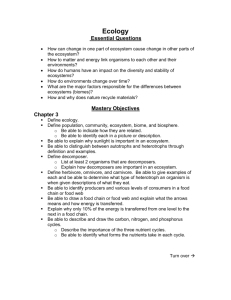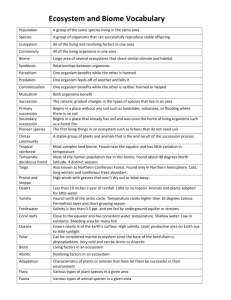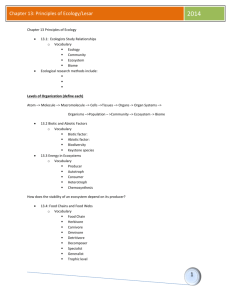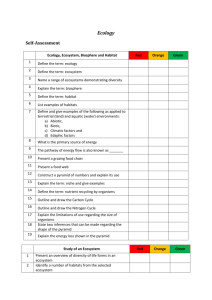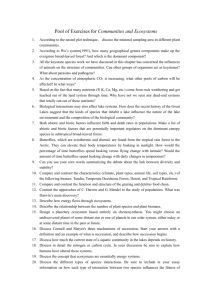Key Learning of the Unit:
advertisement
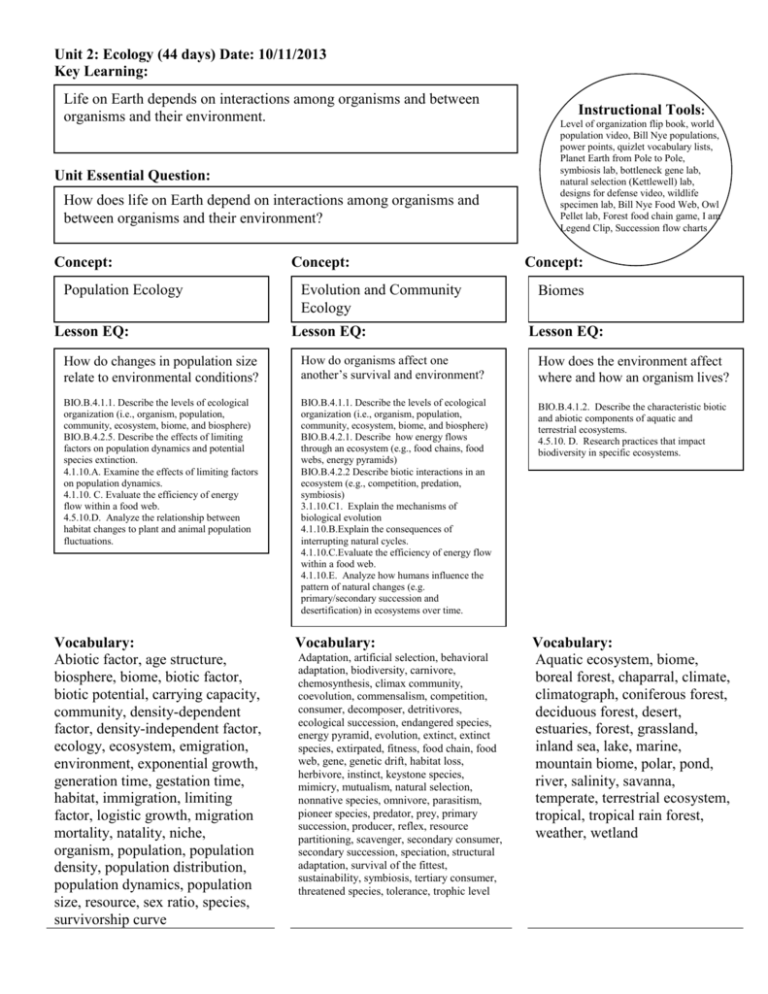
Unit 2: Ecology (44 days) Date: 10/11/2013 Key Learning: Life on Earth depends on interactions among organisms and between organisms and their environment. Unit Essential Question: How does life on Earth depend on interactions among organisms and between organisms and their environment? Concept: Population Ecology Lesson EQ: Concept: Evolution and Community Ecology Lesson EQ: Instructional Tools: Level of organization flip book, world population video, Bill Nye populations, power points, quizlet vocabulary lists, Planet Earth from Pole to Pole, symbiosis lab, bottleneck gene lab, natural selection (Kettlewell) lab, designs for defense video, wildlife specimen lab, Bill Nye Food Web, Owl Pellet lab, Forest food chain game, I am Legend Clip, Succession flow charts Concept: Biomes Lesson EQ: How do changes in population size relate to environmental conditions? How do organisms affect one another’s survival and environment? How does the environment affect where and how an organism lives? BIO.B.4.1.1. Describe the levels of ecological organization (i.e., organism, population, community, ecosystem, biome, and biosphere) BIO.B.4.2.5. Describe the effects of limiting factors on population dynamics and potential species extinction. 4.1.10.A. Examine the effects of limiting factors on population dynamics. 4.1.10. C. Evaluate the efficiency of energy flow within a food web. 4.5.10.D. Analyze the relationship between habitat changes to plant and animal population fluctuations. BIO.B.4.1.1. Describe the levels of ecological organization (i.e., organism, population, community, ecosystem, biome, and biosphere) BIO.B.4.2.1. Describe how energy flows through an ecosystem (e.g., food chains, food webs, energy pyramids) BIO.B.4.2.2 Describe biotic interactions in an ecosystem (e.g., competition, predation, symbiosis) 3.1.10.C1. Explain the mechanisms of biological evolution 4.1.10.B.Explain the consequences of interrupting natural cycles. 4.1.10.C.Evaluate the efficiency of energy flow within a food web. 4.1.10.E. Analyze how humans influence the pattern of natural changes (e.g. primary/secondary succession and desertification) in ecosystems over time. BIO.B.4.1.2. Describe the characteristic biotic and abiotic components of aquatic and terrestrial ecosystems. 4.5.10. D. Research practices that impact biodiversity in specific ecosystems. Vocabulary: Abiotic factor, age structure, biosphere, biome, biotic factor, biotic potential, carrying capacity, community, density-dependent factor, density-independent factor, ecology, ecosystem, emigration, environment, exponential growth, generation time, gestation time, habitat, immigration, limiting factor, logistic growth, migration mortality, natality, niche, organism, population, population density, population distribution, population dynamics, population size, resource, sex ratio, species, survivorship curve Vocabulary: Adaptation, artificial selection, behavioral adaptation, biodiversity, carnivore, chemosynthesis, climax community, coevolution, commensalism, competition, consumer, decomposer, detritivores, ecological succession, endangered species, energy pyramid, evolution, extinct, extinct species, extirpated, fitness, food chain, food web, gene, genetic drift, habitat loss, herbivore, instinct, keystone species, mimicry, mutualism, natural selection, nonnative species, omnivore, parasitism, pioneer species, predator, prey, primary succession, producer, reflex, resource partitioning, scavenger, secondary consumer, secondary succession, speciation, structural adaptation, survival of the fittest, sustainability, symbiosis, tertiary consumer, threatened species, tolerance, trophic level Vocabulary: Aquatic ecosystem, biome, boreal forest, chaparral, climate, climatograph, coniferous forest, deciduous forest, desert, estuaries, forest, grassland, inland sea, lake, marine, mountain biome, polar, pond, river, salinity, savanna, temperate, terrestrial ecosystem, tropical, tropical rain forest, weather, wetland
